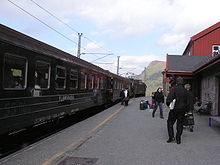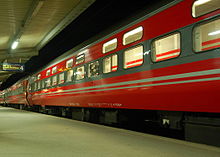- Norwegian railway carriages
-
There are three basic types of Norwegian railway carriage used commonly by NSB on the Norwegian railway system, the Class 3, Class 5 and Class 7 series. As of 2005, the carriages are hauled by NSB El 18 engines on the main electrified stretches and NSB Di 4 engines on non-electrified lines.
Contents
Coding
In general the preceding letter of the carriage type indicates what the carriage is used for. For example
- A indicates a first class carriage.
- B indicates a second class carriage, this is the most common.
- AB indicates a carriage with both first class and second class seating.
- C indicates some sort of "special" carriage, such as one with a playing room for families with children.
- F indicates a luggage carriage.
- R indicates a restaurant carriage.
- WL indicates a sleeping carriage.
A B5 carriage is thus the "typical" second-class carriage in the Class 5 series, while an A5 carriage is a first class version of it.
Class 3 series
These carriages were built between 1962 and 1974 by Strømmen and are the oldest carriages in common use. They have four recessed slam doors, two in each end. The carriages are partitioned into two saloons, the second class carriage usually has 60 seats. B3 carriages with a higher passenger density are also used on Flåmsbana where they are hauled by NSB El 17 engines. A B3 carriage is 23.5 metres long and weighs 36.4 to 42 tonnes.
The WLAB carriages were the older sleeping carriages used on night trains. The cabins had three bunks stacked on top of one another. They were retired from service in January 2006.
Class 5 series
Main article: NSB B5These carriages are visually quite similar to the B3 series. The doors are flush with the car sides and sliding rather than conventional slam doors, and on most carriages, all the seating is in one large saloon. The B5s were built by Strømmen between 1977 and 1981. They are slightly larger than the B3, the specifications are 25.3 m long over buffers, 42 tonnes heavy and seat up to 68 passengers. They are used mostly on mid-distance trains to supplement the Class 70 trainsets.
The BF13 and BF14 are versions of the B5 with cabins for families with small children and people with physical disabilities. They also have a small conductor's compartment.
Class 7 series
These carriages are the longest ones operated by NSB. They are used mostly for express trains on the Bergen Line, the Dovre Line and the Sørland Line. They were built by Strømmen between 1982 and 1989. The Class 7 is and looks considerably more modern than the Class 3 and Class 5, with convex sides and low "aircraft-style" windows. Most of the B7s have two saloons, a smaller one with 24 seats and a larger with 46 seats. The cars are 26.1 m long and weigh about 45 tonnes (50 tons). Most trains with Class 7 carriages have one car with a playroom for families with children (BC7).
All Class 7 cars underwent extensive refurbishment in the period 2008–2011, including improved facilities for disabled passengers, power outlets at all seats, WiFi and free access to Internet. These cars will be used on the Bergen Line (Oslo–Bergen) and Dovre Line (Oslo–Trondheim), replacing the Class 73 trains.[1]
A usual Class 7 day train consists of 6 or 7 coaches:
- A7 (1st class)
- BC7 (playroom, wheelchair area)
- B7-6 (2nd class)
- FR7 (bistro)
- 2-3 x B7-4 (2nd class)
A usual Class 7 night train consists of 5 to 7 coaches:
- 2-3 WLAB2 (sleeping coach)
- FR7 (bistro)
- 2-3 x B7-4 (2nd class)
The WLAB2 is the newest, and since the retirement of the old WLAB carriages, the only type of sleeping carriage which is used on night trains on the Bergen, Dovre Sørland and Nordland Lines. The cabins have one or two bunks depending on the fare the passenger pays.
References
- Jernbane.net entry on carriages (Norwegian)
- List of Norwegian train setups (Norwegian)
- ^ Attende til framtida Bergens Tidende (bt.no) November 24, 2008
External links
Norwegian rolling stock Locomotives SteamI · II · III · IV · V · VI · VII · VIII · IX · X · XI · XII · XIII · XIV · XV · XVI · XVII · XVIII · XIX · XX · XXI · XXII · XXIII · XXIV · XXV · XXVI · XXVII · XXVIII · XXIX · A · B · C · 1 · 2 · 3 · 4 · 5 · 6 · 7 · 8 · 9 · 10 · 11 · 12 · 13 · 14 · 15 · 16 · 17 · 18 · 19 · 20 · 21 · 22 · 23 · 24 · 25 · 26 · 27 · 28 · 29 · 30 · 31 · 32 · 33 · 34 · 35 · 36 · 37 · 38 · 39 · 40 · 41 · 42 · 43 · 44 · 45 · 46 · 47 · 48 · 49 · 50 · 51 · 52 · 53 · 54 · 55 · 56 · 61 · 63ElectricDieselShunterEa 1 · 201 · 202 · 203 · 204 · 205 · 206 · 207 · 208 · 209 · 210 · 211 · 212 · 213 · 214 · 215 · 216 · 217 · 218 · 219 · 220 · 221 · 222 · 223 · 224 · 225 · 226Multiple units ElectricDieselCars PassengerCategories:- Railway coaches of Norway
Wikimedia Foundation. 2010.



